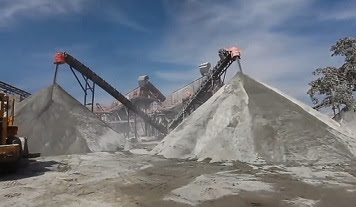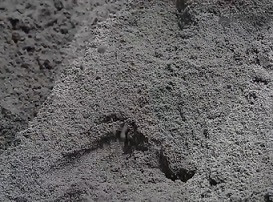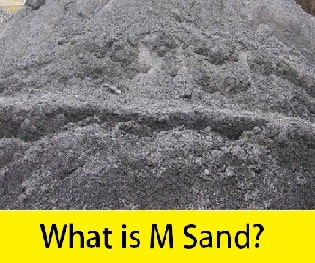Table of Contents
What is M Sand?
The full form of M Sand is Manufactured sand also known as crushed sand or manufactured fine aggregate. It is a substitute for river sand for construction work.
It is manufactured by crushing rocks, quarry stones or larger aggregate pieces into sand size particles in a factory or quarry.
Crushed sand has a cubical and angular shape. It has a size of less than 4.75 mm.
Why Manufactured Sand Is Used?
Extracting river sand from the river is harmful to the environment it reduces the groundwater level and river water gets dried up.
Water table level gets reduced due to dragging of the sand from the river and the roots of the tree may not be able to get the water in the absence of sand in river water get evaporated due to direct sunlight.
It is recommended to use crushed sand. It is an economical and eco-friendly alternative to natural sand.
Crushed sand can be used in construction for all items except plaster and waterproofing work and bedding under the stone. For hardscape work 50% m sand and 50% rivers and should be used for better results.
Also, Read – M Sand Vs River Sand – Difference Between M Sand and River Sand
Properties of M Sand
- The shape of Crushed sand is cubicle and Angular and has a rough texture and hence it is better for concrete.
- It does not contain silt as it is manufactured by crushing aggregate however if screening is not proper sometimes it may contain some dust.
- It doesn’t contain any moisture.
- When it is used in concrete the setting time of concrete is comparatively faster.
- The compressive strength and flexural strength of concrete made from m sand are higher than natural sand.
- When it is used in concrete the permeability of concrete is very poor as compared to river sand.
- It is artificially manufactured so there are no oversized materials.
- The water absorption of crushed sand is 2 to 4 %.
- The slump of crushed sand is less as compared to reverse sand.
- It does not contain any Marine Products.

- The bulk density of crushed sand is 1.75 gm/cm3.
- The specific gravity of crushed sand is 2.5 to 2.9 and it depends on the parent rock.
- While using Crushed sand in concrete there is no need to bulkage correction during mix design.
- The ability to old surface moisture of Crushed sand is up to 10%.
- It has less adulteration than the river sand
- It causes less damage to the environment as compared to natural sand.
- It has better quality as compared to natural sand because it is manufactured in a controlled environment.
- It can be produced in the area closer to the construction site. Bringing down the cost of transportation and providing and assurance of consistent supply.
- It is highly recommended for RCC work, brickwork and block works.
- It is cheaper than river sand. The rate of crushed sand is approximately 1000 per cubic meter.
Also, read – What Is Fineness Modulus of Sand?
Advantages of M sand

- It is well graded in the required proportion for construction.
- It does not contain an organic and soluble compound that affects cement setting time.
- It is artificially manufactured so required property can be obtained.
- It does not contain impurities such as clay, silt thus increases the quality and durability of concrete.
- It is cheaper than river sand.
- It is an economical and eco-friendly material.
Disadvantages of M Sand

- The workability of concrete manufactured with M sand is lesser than that manufactured with natural said. But this can be maintained by using a water-reducing admixture (Superplastsizer).
- The shape of the river sand is rounded and has a smooth surface. Besides the shape of M sand is a cubicle and Angular and has a rough texture due to this cement paste required to fill gaps in concrete prepared using the river sand is less compared to M sand. Thus m sand requires more water and cement requirement to achieve the expected workability leading to increased costs.
- The Other disadvantages of M sand are that m sand contains larger amounts of micro-fine particles than natural sand going to its production process. this again can affect the strength and workability of the concrete.
Thanks for reading this article. If you found this article helpful please don’t forget to share it.
Also, read
Unit Weight of Building Materials Used In Construction
Plum Concrete – Purpose, Ratio, Specification and Uses
Water-Cement Ratio – Definition, Importance, Calculation
House Construction Cost Calculator Excel Sheet
Building Estimate – Importance, Estimate of Building In Excel sheet
Standard Room Sizes & Their Location In Residential Building